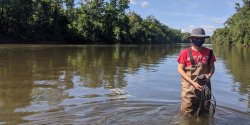Dissolved Oxygen
Oxygen is essential for fish and other aquatic plants and animals, and is therefore one of the most important measurements for determining the overall health of a waterbody. Oxygen in water is measured in its dissolved form as dissolved oxygen (DO); this measurement is typically expressed in units of milligrams (mg) of dissolved oxygen per liter (L) of water or as percent saturation. Temperature controls the amount of dissolved gasses present in water; cold water holds more dissolved gasses than warm water. The concentration of dissolved oxygen influences aquatic community composition. While most cold water fish require a minimum of 4-6 mg/L of DO to survive, some species of fish can tolerate levels of only 2.5 to 3 mg/L DO before showing signs of stress.
Biological processes, such as respiration and the decomposition of organic matter by microorganisms, can reduce the concentration of DO in water; an increased nutrient load (eutrophication) can speed up the rate of these processes. This low oxygen content in the water can produce “dead zones,” where aquatic organisms such as fish can’t survive. This is most likely to occur during hot summer months, in small to medium size lakes with elevated nutrient levels.
At NJCWST, we are certified by the New Jersey Department of Environmental Protection to conduct YSI measurements to accurately determine the dissolved oxygen (DO) content in surface waters (Standard Method 4500-O G-11, Membrane Electrode).
pH
Chemical and biological processes can be greatly influenced by the pH of water. Changes in pH may be triggered by biological activities (respiration and photosynthesis), atmospheric deposition (acid rain), weathering of surrounding rocks, agricultural runoff, and certain wastewater discharges among others. Different organisms tolerate different ranges in pH, but most aquatic animals prefer a range of 6.5-8.0. When exposed to suboptimal pH levels, organisms experience physiological stress; adverse effects include reduced reproductive capacity and lower offspring survival rates. The pH can also impact the bioavailability of toxic elements and compounds. This can produce conditions that are toxic to aquatic life, particularly for sensitive species like rainbow trout. The pH of the water column influences other aspects of lake, river or pond chemistry. Under alkaline (high pH) conditions, increased amounts of nutrients can be released from sediments; acidic (low pH) conditions will release a lower amount of nutrients from sediments. Conversely, higher concentrations of metals can be released from sediments in acidic waters, and lesser concentrations of metals can be released from sediments in alkaline waters.
At NJCWST, we are certified by the NJDEP to offer YSI measurements to accurately measure pH in surface waters (Standard Method 2550 B-10, Electrometric).
Conductivity & Salinity
Conductivity is the measurement of water’s ability to conduct an electrical current, and it increases with the concentration of ions in the water.-As salts dissolve in water, ions are released. All natural water bodies contain salts which are derived from the weathering of minerals found in rocks and soils. Natural water bodies typically have a relatively constant range of conductivities when averaged across the seasons, and conductivity measurements are made over time so that a baseline value can be established.
The conductivity of water can make a big impact on the life history of aquatic organisms, because they must maintain optimal concentrations of water and ions relative to their external environment. Therefore, changes in the baseline ion concentrations in an environment will often precede ecological disruptions. Human activities that can increase the salt content of a given water body include spreading of road salt in the winter months, increases in stormwater runoff, and defoliation of riparian areas. Large changes in water conductivity can indicate that a source of pollution has entered the water.
At NJCWST, we are certified by the NJDEP to offer YSI measurements to accurately measure specific conductance (USEPA certified Method 120.1) and salinity (Standard Method 2520 B, Electrical conductivity) of water bodies. Conductivity measurements are reported in units of micro-Siemens per centimeter (µS/cm) or milli-Siemens/cm (mS/cm). Salinity is reported as parts per thousand (ppt).
Temperature
The physiological performance of aquatic organisms can be greatly affected by ambient water temperatures. Depending on organisms’ optimal and tolerable temperature ranges, fluctuations in temperature can have negligible, mild, or even deadly effects. Although some species may be able to migrate to more suitable habitats, the dangers associated with sharp fluctuations still pose a great threat. Threats to immobile species can be even greater.
The metabolic rates of aquatic plants and animals can increase in response to higher ambient temperatures. Increased water temperatures can also reduce the DO capacity of water and degrade the habitat of fish and larval amphibians. Trout that rely on colder waters, typically for the oxygen enrichment, can be suffocated by abnormally warm periods. Unseasonal temperature drops can stunt our even kill such species. It should be noted, though, that higher than average temperatures, especially when coupled with nutrient enrichment can lead to harmful algal blooms (HABs). When toxin producing species outcompete the abundance of harmless algal species, these HABs can represent a serious threat for the safety of water users and, consequently, for the economy of local communities.
At NJCWST, we are certified by New Jersey Department of Environmental Protection to offer YSI measurements to accurately measure water temperature in surface waters (Standard Method 2550 B-10, Thermometric)
